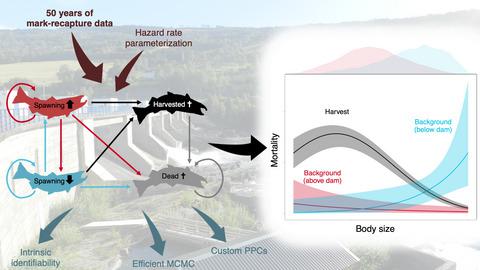当前位置:
X-MOL 学术
›
J. Anim. Ecol.
›
论文详情
Our official English website, www.x-mol.net, welcomes your
feedback! (Note: you will need to create a separate account there.)
Size‐ and stage‐dependence in cause‐specific mortality of migratory brown trout
Journal of Animal Ecology ( IF 3.5 ) Pub Date : 2020-06-25 , DOI: 10.1111/1365-2656.13269 Chloé R Nater 1 , Yngvild Vindenes 1 , Per Aass 2 , Diana Cole 3 , Øystein Langangen 1 , S Jannicke Moe 4 , Atle Rustadbakken 5 , Daniel Turek 6 , Leif Asbjørn Vøllestad 1 , Torbjørn Ergon 1
Journal of Animal Ecology ( IF 3.5 ) Pub Date : 2020-06-25 , DOI: 10.1111/1365-2656.13269 Chloé R Nater 1 , Yngvild Vindenes 1 , Per Aass 2 , Diana Cole 3 , Øystein Langangen 1 , S Jannicke Moe 4 , Atle Rustadbakken 5 , Daniel Turek 6 , Leif Asbjørn Vøllestad 1 , Torbjørn Ergon 1
Affiliation

|
Evidence-based management of natural populations under strong human influence frequently requires not only estimates of survival but also knowledge about how much mortality is due to anthropogenic versus natural causes. This is the case particularly when individuals vary in their vulnerability to different causes of mortality due to traits, life-history stages, or locations. Here, we estimated harvest and background (other cause) mortality of a landlocked migratory salmonid over half a century. In doing so, we quantified among-individual variation in vulnerability to cause-specific mortality resulting from differences in body size and spawning location relative to a hydropower dam. We constructed a multistate mark-recapture model to estimate harvest and background mortality hazard rates as functions of a discrete state (spawning location) and an individual time-varying covariate (body size). We further accounted for among-year variation in mortality and migratory behavior and fit the model to a unique 50-year time-series of mark-recapture-recovery data on brown trout (Salmo trutta) in Norway. Harvest mortality was highest for intermediate-sized trout, and outweighed background mortality for most of the observed size range. Background mortality decreased with body size for trout spawning below the dam and increased for those spawning above. All vital rates varied substantially over time, but a trend was evident only in estimates of fishers' reporting rate, which decreased from over 50% to less than 10% throughout the study period. We highlight the importance of body size for cause-specific mortality and demonstrate how this can be estimated using a novel hazard rate parameterisation for mark-recapture models. Our approach allows estimating effects of individual traits and environment on cause-specific mortality without confounding, and provides an intuitive way to estimate temporal patterns within and correlation among different mortality sources.
中文翻译:

迁徙褐鳟鱼因特定死亡率的大小和阶段依赖性
在人类强大影响下对自然种群进行循证管理,通常不仅需要估计生存率,还需要了解人为与自然原因造成的死亡率。尤其是当个体由于特征、生活史阶段或地点而对不同死亡原因的脆弱性不同时。在这里,我们估计了半个世纪以来内陆洄游鲑鱼的收获和背景(其他原因)死亡率。在此过程中,我们量化了个体之间因体型和产卵位置相对于水电站大坝的差异而导致的特定原因死亡率的差异。我们构建了一个多状态标记重新捕获模型来估计收获和背景死亡率风险率作为离散状态(产卵位置)和个体时变协变量(体型)的函数。我们进一步考虑了死亡率和迁徙行为的年间变化,并将模型拟合到挪威褐鳟鱼(Salmo trutta)独特的 50 年时间序列标记-重新捕获-恢复数据。中等大小的鳟鱼的收获死亡率最高,并且在大多数观察到的大小范围内超过了背景死亡率。在大坝下方产卵的鳟鱼的背景死亡率随着体型的增大而降低,而在大坝上方产卵的鳟鱼则增加。随着时间的推移,所有生命率都有很大差异,但趋势仅在对渔民报告率的估计中是明显的,在整个研究期间,从超过 50% 下降到不到 10%。我们强调了身体大小对特定原因死亡率的重要性,并展示了如何使用标记-重新捕获模型的新型危险率参数化来估计这一点。我们的方法允许在没有混淆的情况下估计个体特征和环境对特定原因死亡率的影响,并提供一种直观的方法来估计不同死亡率来源内的时间模式和相关性。
更新日期:2020-06-25
中文翻译:

迁徙褐鳟鱼因特定死亡率的大小和阶段依赖性
在人类强大影响下对自然种群进行循证管理,通常不仅需要估计生存率,还需要了解人为与自然原因造成的死亡率。尤其是当个体由于特征、生活史阶段或地点而对不同死亡原因的脆弱性不同时。在这里,我们估计了半个世纪以来内陆洄游鲑鱼的收获和背景(其他原因)死亡率。在此过程中,我们量化了个体之间因体型和产卵位置相对于水电站大坝的差异而导致的特定原因死亡率的差异。我们构建了一个多状态标记重新捕获模型来估计收获和背景死亡率风险率作为离散状态(产卵位置)和个体时变协变量(体型)的函数。我们进一步考虑了死亡率和迁徙行为的年间变化,并将模型拟合到挪威褐鳟鱼(Salmo trutta)独特的 50 年时间序列标记-重新捕获-恢复数据。中等大小的鳟鱼的收获死亡率最高,并且在大多数观察到的大小范围内超过了背景死亡率。在大坝下方产卵的鳟鱼的背景死亡率随着体型的增大而降低,而在大坝上方产卵的鳟鱼则增加。随着时间的推移,所有生命率都有很大差异,但趋势仅在对渔民报告率的估计中是明显的,在整个研究期间,从超过 50% 下降到不到 10%。我们强调了身体大小对特定原因死亡率的重要性,并展示了如何使用标记-重新捕获模型的新型危险率参数化来估计这一点。我们的方法允许在没有混淆的情况下估计个体特征和环境对特定原因死亡率的影响,并提供一种直观的方法来估计不同死亡率来源内的时间模式和相关性。











































 京公网安备 11010802027423号
京公网安备 11010802027423号